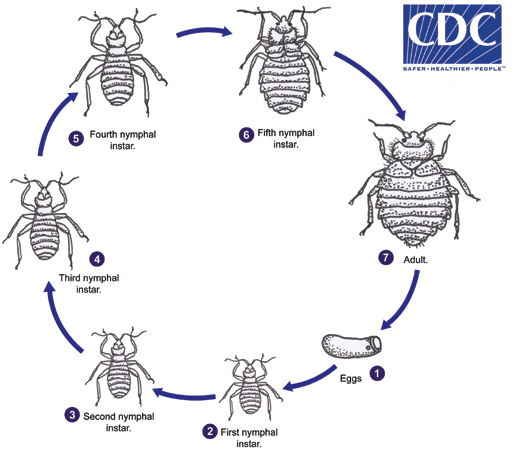Biology
Causal Agent:
The two species of bed bugs (Insecta: Hemiptera: Cimicidae) usually implicated in human infestations are Cimex lectularius and C. hemipterus. Although rare, humans may become incidental hosts of Cimex species of bats and birds.
Life Cycle:

Adults and all nymphal stages of Cimex spp. need to take blood meals from warm-blooded hosts, which are typically humans for C. lectularius and C. hemipterus, although other mammals and birds can be utilized in the absence of a human host. Female bed bugs lay about five eggs ![]() daily throughout their adult lives in a sheltered location (mattress seams, crevices in box springs, spaces under baseboards, etc). Eggs hatch in about 4-12 days into first instar nymphs
daily throughout their adult lives in a sheltered location (mattress seams, crevices in box springs, spaces under baseboards, etc). Eggs hatch in about 4-12 days into first instar nymphs ![]() which must take a blood meal before molting to the next stage. The bugs will undergo five nymphal stages (
which must take a blood meal before molting to the next stage. The bugs will undergo five nymphal stages ( ![]() ,
, ![]() ,
, ![]() ,
, ![]() ,
, ![]() ), each one requiring a blood meal before molting to the next stage, with the fifth stage molting into an adult
), each one requiring a blood meal before molting to the next stage, with the fifth stage molting into an adult ![]() . Nymphs, although lacking wing buds, resemble smaller versions of the adults. Nymphs and adults take about 5-10 minutes to obtain a full blood meal. The adults may take several blood meals over several weeks, assuming a warm-blooded host is available. Mating occurs off the host and involves a unique form of copulation called 'traumatic insemination' whereby the male penetrates the female’s abdominal wall with his external genitalia and inseminates into her body cavity. Adults live 6-12 months and may survive for long periods of time without feeding.
. Nymphs, although lacking wing buds, resemble smaller versions of the adults. Nymphs and adults take about 5-10 minutes to obtain a full blood meal. The adults may take several blood meals over several weeks, assuming a warm-blooded host is available. Mating occurs off the host and involves a unique form of copulation called 'traumatic insemination' whereby the male penetrates the female’s abdominal wall with his external genitalia and inseminates into her body cavity. Adults live 6-12 months and may survive for long periods of time without feeding.
Life cycle image and information courtesy of DPDx.
- Page last reviewed: March 17, 2015
- Page last updated: March 17, 2015
- Content source:


 ShareCompartir
ShareCompartir